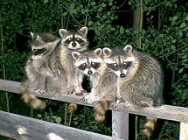Wildlife in Culver City - Raccoons
These wild neighbors just want a home to call their own. From a raccoon's point of view, humans can be very helpful neighbors: We raise crops (food), construct buildings (shelter), and lay down storm sewers (transportation at night and a place to sleep during the day). But their ability to take advantage of what people have-usually unintentionally-offered gets raccoons into trouble. Requests for help with "problem" raccoons bring in a lot of money for "nuisance" wildlife control companies. A more effective, inexpensive, and humane solution is to start with tolerance, learn how the problems start, and practice prevention. Are you sure you're dealing with a raccoon? Sometimes raccoons are blamed for damage they don't do (it may be your neighbor's dog who's rummaging in the trash). The first step to take is to make sure it's a raccoon you're dealing with. Look at the clock: If you hear sounds in the house or the trash is knocked over during the day, it's probably not a raccoon who's causing you concern. But if the sounds in your house start at dusk and then again around dawn, you're probably sharing your home with a raccoon. Problems and solutions inside the house: Raccoon in attic Raccoons can get into attics in a number of ways at any time of the year, but they are more likely to visit in winter and spring. In spring, a mother may choose an attic as a safe spot for giving birth to and raise her young. Evicting a raccoon can be difficult. There are potential safely risks to the home owner and humane concerns for the raccoons if the eviction isn't done properly. We strongly recommend professional assistance to deal with raccoons in an attic. You'll find suggestions for choosing a company in Seven Tips for Choosing a Wildlife Control Company. If you decide to solve the problem yourself, read our general guidelines for evicting and excluding raccoons. Raccoon in chimney A mother raccoon sees an uncapped chimney, and she sees a perfect nursery. It's a safe and sheltered place to give birth to and raise her young until they are able to get around on their own. The fireplace chimney is preferred because the "smoke shelf" is a convenient size to nestle with her kits, but she may also use the chimney venting a furnace. The good news for people who don't welcome a nursery in their home is that the family will move out on its own. Once the raccoons are gone, install an approved chimney cap to prevent future visits. If you can't wait for the family to leave, we urge you to follow this cardinal rule: Never use smoke or fire to drive animals out of chimneys. You will kill young raccoons not mature enough to climb and may even kill adults. Raccoon coming in via a pet door Occasionally, a raccoon will enter a house through a pet door and then fail to find her way back out. You can easily prevent this by not having an unsecured or unsecurable pet door. But if you find it's too late for prevention, follow these steps: - Stay calm. A panicked raccoon can cause a lot of damage, so you'll help the situation by keeping cool yourself. - Move quietly and slowly and try to nudge her back out the way she came in. - If you can do so safely, close doors to other parts of the house. - Open windows and doors that lead outside. - Wait quietly for the raccoon to escape. - If the raccoon doesn't leave, call your local animal control agency for assistance. Never try to catch or handle a raccoon. Leave that for the professionals. Humane raccoon eviction and harassment The first thing to do is to find out if your unwanted guests are a mother with young. If so, the best thing to do is wait a few weeks until the babies grow old enough to leave with their mother. They will not survive without their mother. Don't try to trap and relocate the family yourself. It almost always leads to separation and probable death of the young unless done by a professional who is skilled in reuniting mothers with their offspring. The reunion approach must employ a strategy that lets the mother move the young to another den site within her existing home range, at her own pace. A note about one-way doors: Some professionals use a "one-way door" to get raccoons out of attics or crawl spaces. These require particular care and sensitivity in their use, to be sure that mothers are not isolated from their litters. The young must be old enough and mobile enough to exit through the one-way door with their mother, and this can be very hard to assess. If you know that you are dealing with adults, you can start using humane techniques to evict them. Start small-gentle techniques may be all you need. Try bright lights, loud noises (set a loud radio in the attic or in the fireplace), and unpleasant smells (try a bowl of cider vinegar at the base of the chimney). Combine techniques: multisensory harassment works best - noise, light and smell. Choose the right time, at dusk, right before the mother's normal activity period. Don't drive raccoons out during the day. Raccoons are primarily nocturnal, so they may be confused in daylight, and they are certainly more vulnerable. Convincing the raccoon to leave your house will only give you half a solution to your problem. The second step is to prevent raccoons (or other animals) from entering again. Many people put out a trap, catch the raccoon, and kill or relocate her. But unless you seal off entries into the house, there's nothing to stop another animal from moving in. Exclusion is the only long-term answer. Exclusion (preventing entry or re-entry by raccoons): Attic and home exclusion: Don't use exclusion techniques until you're are absolutely certain all the raccoons have left. For your own and the raccoon's safety, you don't want to trap her inside your house. Before evicting raccoons from your house, monitor their comings and goings so that you can find out how they are getting in. You should also thoroughly inspect your house to detect any possible points of entry . A note about feces: In places where raccoons have lived for a long time, feces may have accumulated. Take care to avoid exposure to roundworm eggs which can be found in raccoon feces. Wear protective clothing and a dust mask, and leave feces undisturbed as much as possible. For safety's sake, hire a professional service to clean up a raccoon latrine. Once you find possible points of entry, and are sure no raccoons are inside, seal them up: Cover all openings with heavy material, such as wire mesh or sheet metal. The best wire mesh for the job is at least 16-gauge material (about 0.06 inches in diameter). Problems and solutions for outside yard Raccoons can damage lawns-especially recently sodded ones- by digging for earthworms and grubs. Because new lawns have to be well irrigated, lots of worms and grubs collect under the sod, which attracts raccoons and, sometimes, skunks. Often they simply reach under the strips and feel around for their meal, pulling out the grubs and worms without causing any damage, but sometimes they'll tear up the sod. This is generally a short-term problem that lasts only as long as the watering does. Solutions: On small areas, try a hot sauce (capsaicin) repellent. On larger areas a band of repellent can be applied around the perimeter, lights can be left on to confuse the raccoons or tip you off to their presence, and a scaring device such as the ScareCrowT sprinkler can be set up to frighten any approaching raccoons. Garden The key here is to act quickly: At the first sign of raccoon damage, step in, because one taste probably won't be enough. Raccoons like both fruits and vegetables: among their favorites are grapes and corn. They often forage your crops just as they are ready to be picked, so extra attention may be necessary just before harvesting the crop. Solutions: Set up a battery-operated radio by your crops, tuned to an all-night talk show, and turn it on for a few nights. Set up single-strand electric fencing around areas where damage is frequent. Ponds Ornamental ponds attract raccoons. They'll eat fish, frogs, or other aquatic life. And they may also tear up plants in search of food. Solutions: If your pond is at least three feet deep in places, try creating hiding places for the fish and frogs by stacking cinder blocks (the kind with the holes) next to one another in groups of three or four, piling rocks, or sinking sections of ceramic tile (the sort used to line chimneys). In extreme cases, and where it is allowed, you can erect single-strand electric fencing around the pond anywhere from four to eight inches off the ground. Trash Raccoons in the trash is not a raccoon problem: it's a trash problem. You can solve this problem by changing how you deal with your trash. Solutions: - Take cans to the curb on the day of pick-up rather than the night before. - Keep cans inside a shed or garage. - Freeze smelly food items such as fish between pick-ups. - Secure the lids with bungee cords, rope tie-downs, or weights. - Purchase trash cans made to keep wildlife from getting inside. Threats to pets Occasionally, raccoons will kill small animals housed outside, such as chickens and rabbits, and they will sometimes be attacked by dogs or get into scraps with cats. Solutions: - Don't allow dogs to roam unsupervised and unleashed. - Keep cats indoors at all times. - House pet rabbits indoors. These practices are in your pet's best interest, regardless of the chance of encountering a raccoon. Encounters between raccoons and pets should be treated very seriously. Consult your veterinarian and local animal-control officials to ensure that your pets have either proper disease protection or adequate follow-up to a potential exposure. |
For injured or orphaned wildlife contact California Wildlife Center Emergencies (310) 458-WILD (9453) Hospital (818) 591-9453 General Inquiries (818) 222-2658 |







